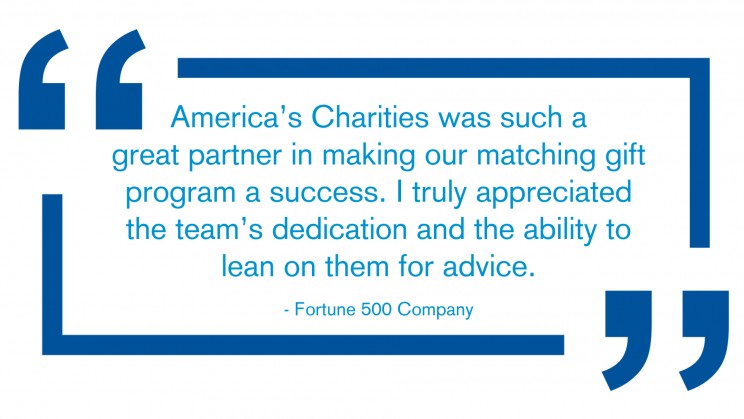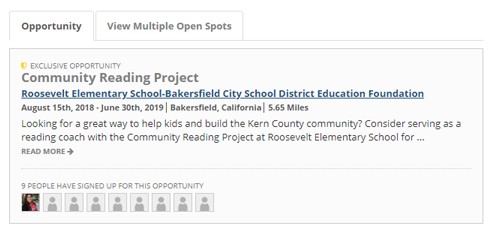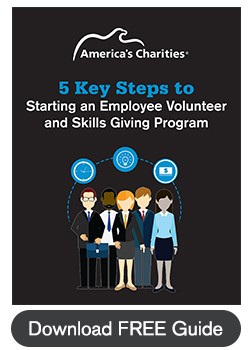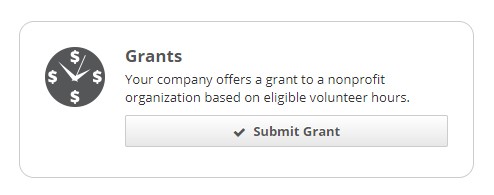Matching Gifts, Volunteering, and Employee Engagement

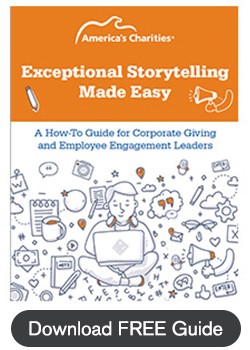 Offering employees the opportunity to give through the workplace is already an incredible benefit in and of itself. In fact, 55% of employees would choose to work for a socially responsible company, even if it meant a lower salary. Your employees are already motivated to rally behind your company in supporting the community and being a force for good through activism.
Offering employees the opportunity to give through the workplace is already an incredible benefit in and of itself. In fact, 55% of employees would choose to work for a socially responsible company, even if it meant a lower salary. Your employees are already motivated to rally behind your company in supporting the community and being a force for good through activism.
But an effective way to further engage your employees and demonstrate your company’s commitment to your workforce while creating social impact is by offering opportunities for your staff to support the causes they care about – then providing incentives to spark and maintain their participation, such as:
With our best-in-class services and range of four employee giving technology solutions to choose from, our team can identify the best fit for your team and help you start rewarding your people.
Matching Gifts
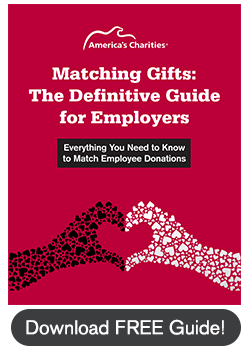
What is Donation Matching and How Does it Work?
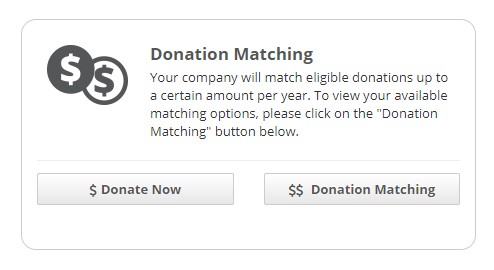
- Matching Gift Budget: Determine how much money your company can afford to set aside for matching employee donations. This number will help you figure out the remaining parameters of your match program and ultimately encourage employee participation.
- Matching Gift Ratio: Companies usually match donations at a 1:1 ratio, but some will match at a 2:1, 3:1, or even a 4:1 ratio. With a 1:1 ratio, if an employee donates $1 then your company would make a matching donation of $1 to that employees’ designated charity. With a 3:1 ratio, if an employee donates $1 then your company would match their donation with $3.
- Matching Gift Caps and Minimums: Setting a donation cap per employee allows your company to ensure it stays within its overall matching gift budget. For example, let’s say you have 400 employees and an overall matching gift budget of $150,000. If you divide your total budget by the total number of employees, you’ll find you can only afford to match up to $375 per employee. But what if a few employees get really excited about your match program and feel extra generous – like donating $1,000 to their favorite charity generous? Setting a matching cap of $375 per employee doesn’t limit how much an employee can donate, but it controls what percentage of their donation you agree to match so you can stay within your budget. On the flip side, it’s a big investment for your company to offer to match employee gifts. Depending on your program goals and how much you hope to raise through your matching gift campaign, you might want to incentivize greater giving by only matching gifts of $25 or more. The max caps and minimum you set are completely up to your team’s employee participation goals and budget.
- Matching Gift Program/Campaign Duration: Will your company match gifts for a limited time period (e.g., a two week campaign) or at the end of the year when your year-long giving program ends for the fiscal year? Will you be holding more than one matching gift campaign throughout the year? You’ll need to keep your budget in mind when thinking through the number of matching gift campaigns you can afford to hold, and you’ll also need to be flexible with the understanding that the match for your 2-week matching gift campaign might exceed its limit within just a few days. If that is the case, will your program end early or does your company have some extra cash it can add to the budget to keep the campaign running and reward even more donors?
- Nonprofits Eligible for Matching Gifts: Will your company match gifts for any of your employees’ designated charities, or will your company match only apply to a handful of specific charities or charities that address a specific cause such as STEM or the environment? You’ll want to think about how your company wants to support its overall social responsibility goals and core causes while weighing how charity choice factors into employee engagement and participation.
Volunteering
The importance of workplace volunteering is accelerating – our own research has shown it is the second most important component of employee engagement programs, and the #1 motivation for workplace donors (even ahead of matching gifts!) As more companies have prioritized corporate volunteering and brought this spirit of innovation to their employee giving programs, they have seen the results: improvements in recruiting and retention, employee satisfaction, leadership and skill development, brand value, innovation, community relationships, employee health, and more.
Interested in Implementing an Employee Volunteer Program?
COVID-19 may have changed many things about the way we live and work, but it hasn’t changed the core of effective employee volunteer and skills-giving programs. Successful programs are employee-driven, have specific business goals with clear strategies, and provide value to nonprofits and the community. If you are looking for guidance, check out these links:
- For those just starting out, check out our free guide, 5 Key Steps to Starting an Employee Volunteer Program, for everything you need to know about starting a program.
- For veterans of workplace volunteering, learn how you can take your existing volunteer program to the next level with our free guide, How to Elevate Employee Engagement and Community Impact Through Workplace Volunteer Programs.
And while the coronavirus hasn’t changed volunteering basics, there are certainly many aspects that have changed.
- Listen to our on-demand webinar, Host Volunteer Events Inclusive of Employees Who Work Remotely, in Person, in Hybrid Situations, and at All Levels of Your Company, to learn how to transition your formerly in-person volunteering program to a virtual environment, engage a distributed workforce in your program, and so much more. Plus, get a copy of the presentation and access to our cause campaign calendar!
Until you have time to dig into those, here are some key things to think about when implementing an employee volunteer program:
Why do you want to start a program? What is driving this initiative?
- Your CEO asked you to?
- Employees have expressed interest?
- You’ve read about the benefits and want to try it out?
- What are your company’s community goals and business priorities?
- Reference your company mission statement and core values.
- Check your business plan and talk with team leaders within different departments to identify short and long-term issues that need to be addressed.
- Consider aligning your program with the UN’s Global Sustainable Development Goals (SDG)
- What outcomes do you hope to achieve for your organization?
- Improve employee recruitment and retention?
- Gain positive PR in the community and for your brand?
- Foster customer loyalty?
- Develop employee skills and increase employee productivity?
- Enhance employee social relations through team building?
- What value do you want to contribute to nonprofits and your community?
- Will you offer paid time off to volunteer or offer dollars for doers service grants?
- Paid volunteer time off (VTO): Employers typically grant each employee anywhere between 8 and 40 hours of VTO per year through this type of program. This allows employees to volunteer at a charity whose cause is close to their heart while volunteering their time around a schedule that works well for them and the nonprofit they are supporting. According to the most recent Employee Benefits Report issued by the Society for HR Management, more than 1 in 4 companies and non-profits in the U.S. offer VTO (a 5% increase over the last five years).
- Dollars for Doers (volunteer grant program): This type of program combines the power of VTO with matching gifts. How it works is your company rewards employees who volunteer a set amount of time by donating a set amount of money to the charity where the employee volunteered. Most employers provide volunteer grants to organizations where employees volunteer on a regular basis, at least 10 hours on average, and specify that the nonprofit must be a 501(c)(3) nonprofit or school. Grant amounts range from anywhere between $250 to $10,000 – so it’s really up to your budget and what you can afford. Double the Donation lists a comprehensive list of some top volunteer grant companies to give you an idea of how your peers are setting up their programs.
- How will your program be managed and measured?
- Do you have the capacity in-house to manage the program or will you require outside support?
- Who will manage the campaign and be the point person from your team?
- Will you track and record employee volunteer participation? If so, how and what will you track?
- Will your volunteer program run year-round or within a defined timeframe?
- What measurements will you use to determine if the program is successful?
Employee volunteer programs are a vital part of your corporate social responsibility efforts. If done well, your program can play an important role in building nonprofit capacity, engaging employees, serving stakeholders, meeting social impact goals, and ensuring your company’s sustainability –not to mention all the positive impact you will have on the community.
America’s Charities offers a comprehensive suite of online giving solutions and services that can help you promote your volunteer program, track and report employee volunteer hours, and integrate volunteerism with the rest of your employee giving program.


